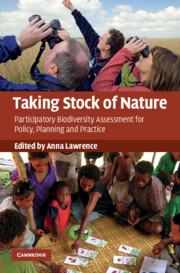Book contents
- Frontmatter
- Contents
- List of contributors
- Acknowledgements
- 1 Introduction: learning from experiences of participatory biodiversity assessment
- 2 Monitoring and assessment of biodiversity under the Convention on Biological Diversity and other international agreements
- 3 The Millennium Ecosystem Assessment: a multi-scale assessment for global stakeholders
- 4 Conservation of biological diversity in El Salvador shade coffee: the importance of taxonomic capacity for participatory assessments
- 5 Taking stock of nature in species-rich but economically poor areas: an emerging discipline of locally based monitoring
- 6 Researching local perspectives on biodiversity in tropical landscapes: lessons from ten case studies
- 7 Participatory resources monitoring in SW China: lessons after five years
- 8 Forest inventory in Nepal – technical power or social empowerment?
- 9 Perceptions of landscape change in British Columbia's Northwest: implications for biodiversity and participatory management
- 10 How thousands planned for a billion: lessons from India on decentralized, participatory planning
- 11 Inside monitoring: a comparison of bird monitoring groups in Slovenia and the United Kingdom
- 12 The personal and political of volunteers' data: towards a national biodiversity database for the UK
- 13 Improving forest management through participatory monitoring: a comparative case study of four community-based forestry organizations in the Western United States
- Index
- References
13 - Improving forest management through participatory monitoring: a comparative case study of four community-based forestry organizations in the Western United States
Published online by Cambridge University Press: 06 December 2010
- Frontmatter
- Contents
- List of contributors
- Acknowledgements
- 1 Introduction: learning from experiences of participatory biodiversity assessment
- 2 Monitoring and assessment of biodiversity under the Convention on Biological Diversity and other international agreements
- 3 The Millennium Ecosystem Assessment: a multi-scale assessment for global stakeholders
- 4 Conservation of biological diversity in El Salvador shade coffee: the importance of taxonomic capacity for participatory assessments
- 5 Taking stock of nature in species-rich but economically poor areas: an emerging discipline of locally based monitoring
- 6 Researching local perspectives on biodiversity in tropical landscapes: lessons from ten case studies
- 7 Participatory resources monitoring in SW China: lessons after five years
- 8 Forest inventory in Nepal – technical power or social empowerment?
- 9 Perceptions of landscape change in British Columbia's Northwest: implications for biodiversity and participatory management
- 10 How thousands planned for a billion: lessons from India on decentralized, participatory planning
- 11 Inside monitoring: a comparison of bird monitoring groups in Slovenia and the United Kingdom
- 12 The personal and political of volunteers' data: towards a national biodiversity database for the UK
- 13 Improving forest management through participatory monitoring: a comparative case study of four community-based forestry organizations in the Western United States
- Index
- References
Summary
Introduction
Community-based forestry (CBF) in the United States (USA) has taken a variety of forms, as resource-dependent communities attempt to balance local social, ecological and economic needs with the preferences of stakeholders outside the community. Although CBF is about more than biodiversity, stakeholders value it for different reasons. This has inspired some community-based organizations to use participatory biodiversity monitoring to assess the impacts of alternative forest restoration activities, address conflicting goals among stakeholders, restore trust and build community in rural areas undergoing rapid demographic and economic changes.
In this chapter we examine such projects in four CBF organizations (CBFOs) that participated in the Ford Community-Based Forestry Demonstration Program. First, we provide background information on community-based forestry in the USA, and some of the theories that informed this research. Then we present the ecological and social contexts and stewardship strategies of our four case study sites, followed by a detailed account of one participatory monitoring project undertaken by each group and the ecological and social outcomes. Finally, we discuss key challenges including the sustainability and replicability of these efforts.
Community-based forestry in the USA
The sustained yield model was the dominant forest management model in the twentieth century, focused on maximizing timber yields in perpetuity (Cortner and Moote, 1994). However, forestry has undergone a profound transformation since the 1980s. In the western states, where much forested land is owned by the federal government, well-publicized environmental conflicts have effectively shut down timber production on federal lands.
- Type
- Chapter
- Information
- Taking Stock of NatureParticipatory Biodiversity Assessment for Policy, Planning and Practice, pp. 266 - 287Publisher: Cambridge University PressPrint publication year: 2010



